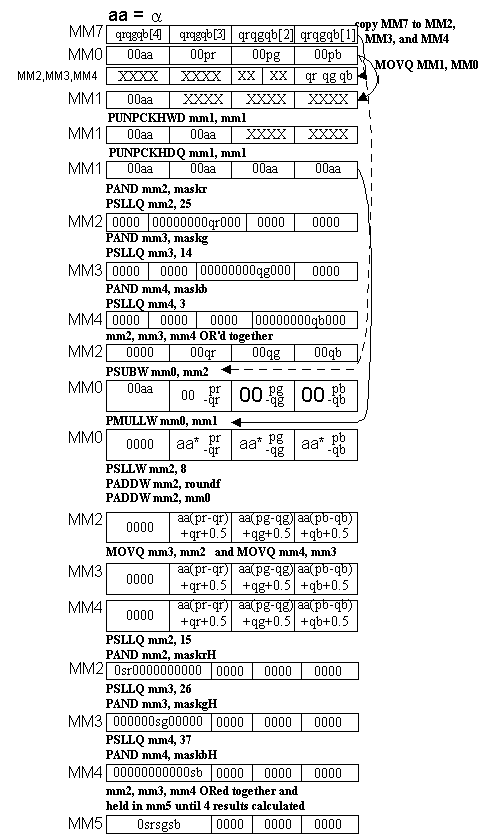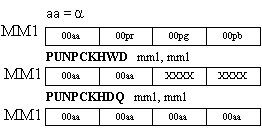|
|
|
|
|
|
|
|

| Disclaimer Information in this document is provided in connection with Intel products. No license, express or implied, by estoppel or otherwise, to any intellectual property rights is granted by this document. Except as provided in Intel's Terms and Conditions of Sale for such products, Intel assumes no liability whatsoever, and Intel disclaims any express or implied warranty, relating to sale and/or use of Intel products including liability or warranties relating to fitness for a particular purpose, merchantability, or infringement of any patent, copyright or other intellectual property right. Intel products are not intended for use in medical, life saving, or life sustaining applications. Intel may make changes to specifications and product descriptions at any time, without notice. Copyright © Intel Corporation (1996). Third-party brands and names are the property of their respective owners.
|
| 1.0. INTRODUCTION |
The Intel Architecture (IA) media extensions include single-instruction, multidata (SIMD) instructions. This application note presents an alpha blending filter used for imaging effects. Specifically, the alpha blending function alphaB demonstrates how the MMX technology shifting capability can be used to organize and calculate the output array efficiently.
Alpha blending is used for imaging effects to merge two images together, weighting one image more than the other. Alpha blending can be used for fading from one image to another or for creating a translucent effect. For example, it can be used to put a 'ghost' image in a picture, or to place a window in an image. The equation for alpha blending is as follows:
where a is the weighting factor, 0 < a < 1, p and q are the input pixels, and s is the alpha blended pixel within the final image
The p array is made up of 32-bit elements. The lower 8 bits are the blue value of the pixel(pb), the next 8 bits are the green value of the pixel(pg), the next 8 bits are the red value of the pixel(pr), and the upper 8 bits are the a value. This pixel format was chosen for this application note since the p array is commonly the result of calculations to determine the proper RGB a values.
The q array is made up of 15-bit values. The lower 5 bits are the blue value of the pixel (qb), the next 5 bits are the green value of the pixel (qg), and the upper 5 bits are the red value of the pixel (qr). The resulting array s is made up of 15-bit values set up in the same order as the q array of pixels. This format, shown in Figure 1, was chosen for this application note since it is a common format for pixels already stored in a high color display buffer.

The alpha blending equation was optimized for MMX technology as follows:
Figure 2 shows a register diagram of the pixel calculations
that are done in the main loop L3. The loop L3 occurs n times
where n is the number of rows times the number of columns in the
images p
and q.
Before the start of loop L3, register MM0 contains the p
pixel value and register MM7 contains the q
pixel value for the current calculation. After the L3 loop occurs
four times the four new s
pixel values are stored over the old q
pixel values.

Notice how the a value is replicated to perform the transformation. In the equation, a must be multiplied by each component of the result of the p-q calculation, namely (p-q)red, (p-q)green, and (p-q)blue. To do this the a comes from the p pixel and is replicated three times for use with each component. This can be accomplished by using the PUNPCKHWD and PUNPCKHDQ instructions with the same register specified for both inputs, as shown in Figure 3.

Approximately 92% of the instructions in the L1 loop are paired in the code presented in this paper. It might be possible to reduce the number of registers used in this loop to four so that the loop may be unrolled to improve the pairing. Also, the optimized technique used in Using MMX Instructions to Convert 24-Bit True Color Data to 16-Bit True High Color, Application Note AP-553 (Order number 243038) for the final packing of the result to 16-bit color format could be used to make the implementation more efficient. For these enhancements, the algorithm presented here would have to be reimplemented.
The following cycle calculations were done by placing assembler tracing calls around both the C function call and the MMX function call that performs the alpha blending operation. The C code was compiled with a maximum speed compiler switch. The input images are 72x58 pixels. The code was traced, and the data file was used to generate a log file which contains the cycle information for each case.
For the scalar version of the alpha blending function:
For the MMX technology version of the alpha blending function:
;*************************************************************************/
;*
;* INTEL Corporation Proprietary Information
;*
;* This listing is supplied under the terms of a CNDA agreement
;* with INTEL Corporation and may not be disclosed except
;* in accordance with the terms of that agreement
;*
;* Copyright (c) 1996 Intel Corporation.
;* All rights reserved.
;*
;*************************************************************************/
;*************************************************************************/
;*
;* File : alphammx.asm Date : 3/4/96
;*;*
;* Description:
;*
;* This routine computes the alpha blending of two 8-bit RGB
;* images as follows :
;*
;* s[r,g,b] = aa * p[r,g,b] + (1-aa) * q[r,g,b]
;*
;* IMPORTANT!!!
;*
;* This function requires that the total number of pixels in
;* the image to be a multiple of 4, i.e. nx*ny = 4N
;*
;* Revision History:
;* Name Date Description
;* ---------------------------------------------------------------------
;*
;*************************************************************************/
title alphaB
include iammx.inc
.486P
.model flat,c
.data
zeros dq 0h
roundf dd 800080h, 80h
maskr dd 7c00h, 0h
maskg dd 3e0h, 0h
maskb dd 1fh, 0h
maskrH dd 0h, 7c000000h
maskgH dd 0h, 3e00000h
maskbH dd 0h, 1f0000h
.code
;------------------------------------------------------------------------
; input: p_ptr pointer to array of [aa:8 pr:8 pg:8 pb:8]
; q_ptr pointer to array of [qr:5 qg:5 qb:5]
; nx number of rows
; ny number of columns
;
; output: q_ptr pointer to array of [sr:5 sg:5 sb:5]
alphaB proc near C uses esi edi eax ebx ecx edx,
p_ptr : ptr dword,
q_ptr : ptr word,
nx : ptr word,
ny : ptr word
;------------------------------------------------------------------------
mov esi, p_ptr ; esi = p
xor eax, eax ; eax = 0
mov edi, q_ptr ; edi = q
xor ecx, ecx ; ecx = 0
mov ax, word ptr nx ; ax = nx
mov cx, word ptr ny ; cx = ny
imul eax, ecx ; eax = nx*ny
L1: movq mm7, mmword ptr [edi] ; mm7 = qqq4 qqq3 qqq2 qqq1
pxor mm5, mm5 ; mm5 = 0000 0000 0000 0000
L2: movq mm6, mmword ptr [esi] ; mm6 = a2r2 g2b2 a1r1 g1b1
movq mm0, mm6 ; mm0 = xxxx xxxx aarr ggbb
add esi, 8 ; esi += 8
L3: punpcklbw mm0, mmword ptr zeros ; mm0 = 00aa 00rr 00gg 00bb
movq mm2, mm7 ; mm2 = xxxx xxxx xxxx qqqq
pand mm2, maskr ; mm2 = 0000 0000 0000 qq00
movq mm1, mm0 ; mm1 = 00aa xxxx xxxx xxxx
movq mm3, mm7 ; mm3 = xxxx xxxx xxxx qqqq
punpckhwd mm1, mm1 ; mm1 = 00aa 00aa xxxx xxxx
pand mm3, maskg ; mm3 = 0000 0000 0000 0qq0
psllq mm2, 25 ; mm2 = 0000 00qr 0000 0000
movq mm4, mm7 ; mm4 = xxxx xxxx xxxx qqqq
psllq mm3, 14 ; mm3 = 0000 0000 00qg 0000
pand mm4, maskb ; mm4 = 0000 0000 0000 00qq
punpckhdq mm1, mm1 ; mm1 = 00aa 00aa 00aa 00aa
por mm2, mm3 ; mm2 = 0000 00qr 00qg 0000
psllq mm4, 3 ; mm4 = 0000 0000 0000 00qb
por mm2, mm4 ; mm2 = 0000 00qr 00qg 00qb
psrlq mm6, 32 ; mm6 >>= 32
psubw mm0, mm2 ; mm0 = p - q
psllw mm2, 8 ; mm2 = 0000 qr00 qg00 qb00
paddw mm2, roundf ; mm2 = q + round'g factor
pmullw mm0, mm1 ; mm0 = (p-q)*aa
psrlq mm5, 16 ; mm5 >>= 16
psrlq mm7, 16 ; mm7 >>= 16
nop
paddw mm2, mm0 ; mm2 = (p-q)*aa+q + round'g factor
movq mm0, mm6 ; mm0 = xxxx xxxx aarr ggbb
movq mm3, mm2 ; mm3 = mm2
psllq mm2, 15 ; mm2 = rrxx xxxx xxxx xxxx
movq mm4, mm3 ; mm4 = mm3
psllq mm3, 26 ; mm3 = xggx xxxx xxxx xxxx
pand mm2, maskrH ; mm2 = rr00 0000 0000 0000
psllq mm4, 37 ; mm4 = xxbb xxxx xxxx xxxx
pand mm3, maskgH ; mm3 = 0gg0 0000 0000 0000
por mm5, mm2 ; mm2 = sss0 0000 0000 0000
pand mm4, maskbH ; mm4 = 00bb 0000 0000 0000
por mm5, mm3 ; mm5 = ssss SSSS SSSS SSSS
por mm5, mm4
dec eax ; -- eax
test eax, 1
jnz L3
test eax, 2
jnz L2
movq mmword ptr [edi], mm5 ; save 4 alpha blended words in q
cmp eax, 0
je L4
add edi, 8 ; edi += 8
jmp L1
L4: emms
ret
alphaB endp
end